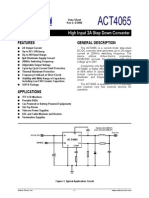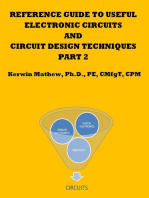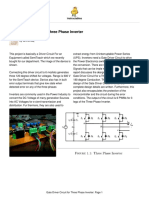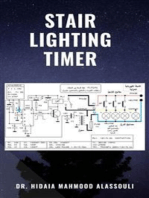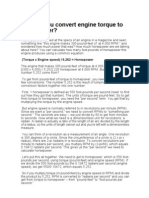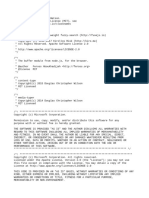Power Supply: Three Pin Voltage Regulator
Power Supply: Three Pin Voltage Regulator
Uploaded by
Ishani PatelCopyright:
Available Formats
Power Supply: Three Pin Voltage Regulator
Power Supply: Three Pin Voltage Regulator
Uploaded by
Ishani PatelOriginal Title
Copyright
Available Formats
Share this document
Did you find this document useful?
Is this content inappropriate?
Copyright:
Available Formats
Power Supply: Three Pin Voltage Regulator
Power Supply: Three Pin Voltage Regulator
Uploaded by
Ishani PatelCopyright:
Available Formats
Power Supply
Power supply is the important part of any electronics unit ( project ) while designing the power supply we have to see the requirement of voltage and current for the project working. Three pin voltage regulator :In the past, the conversion was to provide a single regulator to regulate a line which then supplied power to all circuits comprising an electronic system. This regulator would generally be made up of several discrete components or a low power voltage regulator IC with associated series pass elements . Such a regulator was bulky and would be required to dissipate a large amount of power. With the development and ready availability of three terminal regulators both fixed and adjustable . In a wide range of current and power ratings the trend has moved towards localised regulation with single three terminal regulator fitted on each circuit card. A functional schematic of a three terminal regulator is shown in fig. It is seen that the device is a complete . with built in reference error amplifier, series pass transistor and protection circuits . The protection circuits include current limiting to limit peak output current , safe area protection to limit dissipation in the series pass transistor, and thermal shut down to limit die and junction temperature to a safe value. The reference voltage VREF is a temperature stabilized voltage developed either a zener or a band gap circuit . The error amplifier is a no inverting amplifier which constantly compares a fraction of the output voltage developed across R2 against the reference voltage at its non inverting input. The error amplifier controls the base drive of
the series pass transistor in such a way that the output voltage remains constant, thus achieving Regulation. The current limiting and safe protection circuits , when activated, limit the base drive to the series pass transistor. Thus limiting output current . The thermal shutdown circuit. On the other hand, when activated completely turns off the base drive to the series pass transistor. Thus reducing output off the base drive to the series pass transistor , thus reducing output current to zero . The operation of the protection circuit is better understood by referring to fig. Current limiting :If Vin Vout is less than Vz1 then Vz1 then the current in R3 is zero and only current in R4 due to Q2 s base current. Since this current is negligible, it follows that VBE2 equals the voltage across current sense resistor RCS As the regulator output current increases, the voltage (I0 RSC) developed across RSC also increases until it thrns on Q2 Once Q2 is turned on, it prevents additional base drive from reaching Q3 and hence the output current is limited. Safe Area Protection :Vin Vout is greater the Vz1 a current proportional to ( V in V out ) Vz and hence vin v out flows through Zi R3 and R4 to the output of regulator This places a biase on 02s so that base emitter voltage is greater the bias. Thus Q2 turns ON at lower output current through RSC and the current limit point of the regulator reduces as the Vin V out differential increases. The rate of reduction of current limit. With increase in Vin Vout is equal to. Since with increasing junction temperature a transistor will turn on at a lower base to emitter voltage , the slope of safe area curve will be greater and hence the current limit lower at higher temperature.
Thermal shut down :Thermal shut- down is due to transistor 01 is located in close physical proximity to Q3,Q2> base is biased at about 0.4 volts . which is insufficient to turn it ON at room temperature . However , as die temperature increases, the base emitter voltage necessary to turn ON, Q1 170 Q1 turns ON, diverting all Q3 base drive so that Q3 is turned OFF and regulator current drop to zero allowing the regulator to cool. A hysteresis is built into the thermal shut down circuit so that shut down occurs at several degrees above the temperature at which the regulator can once more turn ON. These devices are extremely easy to use . They require very few or no external components and a minimal of heat sinking they are available for both positive ( 78 Series) and negative output ( 79 series ) voltage and with fixed output voltage options as well as adjustable output voltage ( LM 317) Fixed voltage three terminal regulators are normally available in 5.12.15.18and 24 volts output options. For example. 7815 is a positive voltage regulator whose output is 15V . Similarly LM. 105 is positive voltage regulator while LM 104 is negative voltage regulator. IC 78XX C SERIES :An example of a Motorola MC 78 xx c series of three terminal positive fixed voltage regulator used in basic regulator circuit is shown in fig. The input capacitance C1 is required to cancel inductive effects associated with long power distribution leads, Output capacitor C2 improves the transient response These devices requiring no adjustment have an output present by the manufacturer to an industry standard of 5,69,12,15 ,18 or 24 volts. Such regulators are capable of output current in excess of 1Amp. These have internal short circuit protection which will limit the maximum current, the circuit will pass thermal shut down and output transistor safe operating area protection. Basic circuit using three terminal positive regulator . Typical values for the stabilization coefficients are Sv = 3x 10 Ro =30 milliohms, and St = 1 mV / Centigrade The level of complexity affected by monolithic IC techniques can be appreciated by examining the fig. The circuit diagram of the MC 78x x IC 3
O/P current in excess of 1 amp. Internal thermal over load protection No external component required Internal short circuit current limit Available in aluminum 2-3 package I/p Voltage 10 v 19 v 23 v IC 79XX SERIES :An example of a motorola MC 79XXC series of three terminal negative is shown in fig. The explanation is similar to that of IC 78XX series except that the output voltage is negative. These devices requiring no adjustment have an output preset by the manufacturer to an industry standard of 5-6-9-12-18 and 24 volts. The C1 may be a 0.1 ceramic disc type or a 25 of electrolyte. C2 may be inserted to reduce high frequency noise to ensure stability and error free operation . C2 may be a 1F solid tantalum of 25 F electrolyte. For the programming of the EPROM the Anshuman kit is used IC2716 with its single 5 volt supply. It can be used in six modes of operation viz. Read, output disable, stand by program verity and program inhibit. Due to the advantage of operational amplifier like high input impedance, linearity and high CMRR ( i.e. Common Mode Rejection Ratio). It does not load the DAC and gives the voltage output. It also reduced the distortion by the 1 +AB factor. The band width is large to get a small amplitude variation. Fine adjustment is provided by putting a small value of potentiometer VR3 is series with VR2. IC3 needs 3V to 4V more at its input to give good performance . The bridge rectifier is made using 1N4007 lamp diodes that rectify AC into DC for all digital ICs this supply is prefered. O/p Voltage 5v 12v 15v
For the amplifiers +15V
and 15V supplies are required. IC1 has a specially built
regulated power supply of + 15V it supplies upto 1 amp. Easily without any voltage drop. SHORT CIRCUIT PROTECTION AND OVER VOLTAGE PROTECHTION To the left of the shaded block is the reference voltage VR (Reference to the fig.). This is the level shifter which a zener diode input to the emitter follower buffer. The shaded circuit in fig. Is the difference amplifier Av (refer to the fig. ) The design the similar with the 741 op-amp config . The resistance R1 & R2 in fig corresponds to the same feedback n/w . The darligton pair Q and Q in fig. Constitutes the pass element fig. The protection circuitry is shown in heavy line and merits explanation , Current limiting is performed by R3.R4.R2. Safe operating protection is accomplished in the following way. If the output is pulled low by an overload , thus increasing the collector emitter voltage of Q zener D1 will conduct under this circumstance sufficient base current is supplied to Q2 so that it conducts, which in turn robs bass drive form the Q-Q Darlington combination. Thus the volt ampere product is restricted to reasonable power dissipation. Regarding the thermal overload protection a part of the reference voltage appearing across R5 is applied to the base emitter junction Q3 for a given value of VBE . the collector current 13 increases rapidly as temperature increases . Hence for high temperatures due to power dissipation of a high ambient. Q3 conducts heavily and again starve the pass transistors or a high ambient Q3 conducts heavily and again starve the pass transistors Q-Q of base drive so as to give thermal shut down.
You might also like
- ONAN VR21 Volt. Reg. Op. and TroubleshootingDocument4 pagesONAN VR21 Volt. Reg. Op. and TroubleshootingAbood Ali100% (1)
- Block Diagram: Bridge RectifierDocument6 pagesBlock Diagram: Bridge Rectifierskull hertzNo ratings yet
- Unit VDocument56 pagesUnit Vvlsimicroelectronics.sseNo ratings yet
- 0-30 VDC Stabilized Power Supply With CurrentDocument8 pages0-30 VDC Stabilized Power Supply With CurrentDavid ReyesNo ratings yet
- Ic Voltage RegulatorsDocument11 pagesIc Voltage RegulatorsshreyashNo ratings yet
- Widlar Bandgap PaperDocument6 pagesWidlar Bandgap PapercrglstNo ratings yet
- DCpower SuplyDocument12 pagesDCpower Suplymm30973097No ratings yet
- Three Terminal Fixed and Adjustable Voltage RegulatorsDocument7 pagesThree Terminal Fixed and Adjustable Voltage RegulatorsSơn Trần YNo ratings yet
- 10884Document13 pages10884karthikeidNo ratings yet
- Placa Fonte Chinesa 0 - 30V - 3ADocument14 pagesPlaca Fonte Chinesa 0 - 30V - 3AKelsen Leão PereiraNo ratings yet
- XP 620Document8 pagesXP 620Far PilonNo ratings yet
- Ecler Pam2000 Pam2600 Power Amplifier Service ManualDocument107 pagesEcler Pam2000 Pam2600 Power Amplifier Service Manuallluissb92% (12)
- Module 4-1Document21 pagesModule 4-1abhishekpoly7No ratings yet
- LM317 AppnoteDocument6 pagesLM317 AppnoteLucas Matías JuarezNo ratings yet
- Embedded SystemDocument16 pagesEmbedded Systemdasarajubhavani05No ratings yet
- UnilabDocument5 pagesUnilabshoker4No ratings yet
- Wi-Fi Home AutomationDocument23 pagesWi-Fi Home Automationchandru_8No ratings yet
- TSM 101Document15 pagesTSM 101thiemncNo ratings yet
- Digital Thermometer Report FinalDocument29 pagesDigital Thermometer Report FinalRahul Agarwal100% (1)
- MW Inverter IC RM6203Document7 pagesMW Inverter IC RM6203KybernetikumNo ratings yet
- Power Supply Linear RegulatorDocument11 pagesPower Supply Linear RegulatorSurbhi100% (1)
- Regulated DC Power Supply Lab AssignmentDocument17 pagesRegulated DC Power Supply Lab AssignmentSebastien Paul100% (1)
- Principles Applications ICL7660Document10 pagesPrinciples Applications ICL7660Juan F. RamosNo ratings yet
- Unit VDocument33 pagesUnit VDINESH KUMAR DRAVIDAMANINo ratings yet
- LM7805 Series Voltage RegulatorsDocument5 pagesLM7805 Series Voltage RegulatorsdarknessmonNo ratings yet
- STCC05-B: Home Appliance Control CircuitDocument13 pagesSTCC05-B: Home Appliance Control Circuitsvhanu4010No ratings yet
- RF Controlled ApplianceDocument14 pagesRF Controlled ApplianceNEX456No ratings yet
- Power Supply Theory of OperationDocument6 pagesPower Supply Theory of OperationsaeidraminaNo ratings yet
- E L RelayDocument31 pagesE L RelayBal SubramaniNo ratings yet
- Ncl30160 1.0A Constant-Current Buck Regulator For Driving High Power LedsDocument10 pagesNcl30160 1.0A Constant-Current Buck Regulator For Driving High Power LedsKhúc Hành QuânNo ratings yet
- 0-30 VDC Stabilized Power Supply With Current Control 0.002-3 ADocument12 pages0-30 VDC Stabilized Power Supply With Current Control 0.002-3 Anmgaby21No ratings yet
- IC Voltage RegulatorsDocument32 pagesIC Voltage RegulatorsAnita Thattil100% (1)
- Act 4065Document9 pagesAct 4065bob75No ratings yet
- Lic Report 14 - 4 Final2Document12 pagesLic Report 14 - 4 Final2Harshvardhan MishraNo ratings yet
- The Adapting 3-Terminal Voltage Regulators For Constant High Voltage Power SuppliesDocument5 pagesThe Adapting 3-Terminal Voltage Regulators For Constant High Voltage Power SuppliesHarsh VardhanNo ratings yet
- Mp1423 - MonolithicPowerDocument11 pagesMp1423 - MonolithicPowerJuanKaNo ratings yet
- L200 Design GuideDocument21 pagesL200 Design Guidetxe_scientistNo ratings yet
- Auto Shut OffDocument5 pagesAuto Shut OffJuan Manuel Han MacNo ratings yet
- T.D.A 4605-3Document20 pagesT.D.A 4605-3Jose M PeresNo ratings yet
- DiDocument6 pagesDipani256No ratings yet
- DC-DC Boost Converter For Custom Application by LeenaDocument4 pagesDC-DC Boost Converter For Custom Application by LeenaRekhamtrNo ratings yet
- Catu Daya 723Document6 pagesCatu Daya 723Audi MirantiNo ratings yet
- Reference Guide To Useful Electronic Circuits And Circuit Design Techniques - Part 2From EverandReference Guide To Useful Electronic Circuits And Circuit Design Techniques - Part 2No ratings yet
- LCD Backlight Inverter Drive IC: Features DescriptionDocument14 pagesLCD Backlight Inverter Drive IC: Features DescriptionLuis Antonio Arévalo SifontesNo ratings yet
- 0-30 VDC Stabilized Power Supply With Current Control 0Document33 pages0-30 VDC Stabilized Power Supply With Current Control 0MarioKunditNo ratings yet
- Gate Driver Circuit For Three Phase InverterDocument13 pagesGate Driver Circuit For Three Phase InverterMarc Tcheukaba100% (1)
- Iraudamp1 PDFDocument22 pagesIraudamp1 PDFamijoski6051No ratings yet
- The Adapting 3-Terminal Voltage Regulators For Constant High Voltage Power SuppliesDocument5 pagesThe Adapting 3-Terminal Voltage Regulators For Constant High Voltage Power SuppliesPrateek GoswamiNo ratings yet
- PWM Based Induction Motor Control - 1Document25 pagesPWM Based Induction Motor Control - 1jagannathpressbdkNo ratings yet
- 2.5 Regulated Power SupplyDocument6 pages2.5 Regulated Power SupplyVedantNo ratings yet
- Smart Voltage Stabilizer Using PIC16F877ADocument8 pagesSmart Voltage Stabilizer Using PIC16F877AAswathy CjNo ratings yet
- Ecler Apa2000 Amplifier Service ManualDocument96 pagesEcler Apa2000 Amplifier Service Manualelefantul2005No ratings yet
- Cathodic ProtectionDocument13 pagesCathodic Protectionnamanvyas21No ratings yet
- Remote Control Home Appliance Usinng RF Without MicrocontrollerDocument67 pagesRemote Control Home Appliance Usinng RF Without MicrocontrollerRamalingam Shanmugam100% (1)
- Data Sheet: TDA8380ADocument21 pagesData Sheet: TDA8380Ajvazquez501No ratings yet
- Reference Guide To Useful Electronic Circuits And Circuit Design Techniques - Part 1From EverandReference Guide To Useful Electronic Circuits And Circuit Design Techniques - Part 1Rating: 2.5 out of 5 stars2.5/5 (3)
- Crafter Panel Van-BrochureDocument49 pagesCrafter Panel Van-BrochureMircea PostolacheNo ratings yet
- Core - Security.patterns - Best.practices - And.strategies - for.J2EE - Web.services - And.identity - Management.oct.2005 0131463071Document848 pagesCore - Security.patterns - Best.practices - And.strategies - for.J2EE - Web.services - And.identity - Management.oct.2005 0131463071blackstileNo ratings yet
- Challenges of Performance AppraisalDocument7 pagesChallenges of Performance AppraisalPoulamiNo ratings yet
- ManualDocument68 pagesManualMariana Marinez MoralesNo ratings yet
- Cielo Euro IIIDocument4 pagesCielo Euro IIIAlexandru DavidNo ratings yet
- Whirlpool WED5605MWDocument1 pageWhirlpool WED5605MWalNo ratings yet
- Estoppel Notice Michigan First Credit UnionDocument4 pagesEstoppel Notice Michigan First Credit Unionkingtbrown50No ratings yet
- Contract of Lease: 1. TERM: This Lease Shall Be For A Period of 5 (FIVE)Document4 pagesContract of Lease: 1. TERM: This Lease Shall Be For A Period of 5 (FIVE)Rose Galsn100% (1)
- Concession Contract HandbookDocument19 pagesConcession Contract HandbookDody AdiNo ratings yet
- FALAJ AND IRON AGE SolvedDocument3 pagesFALAJ AND IRON AGE Solveddeborah hildaNo ratings yet
- Lm6000 Power Plants: Simple Cycle Efficiency Simple Cycle OutputDocument1 pageLm6000 Power Plants: Simple Cycle Efficiency Simple Cycle OutputErik Van GroningenNo ratings yet
- PFIZER INC - Group ProjectDocument5 pagesPFIZER INC - Group ProjectJack TraderNo ratings yet
- Japan Itinerary 2023Document7 pagesJapan Itinerary 2023neel.k.iyerNo ratings yet
- (PC) Yonai v. Teaford Et Al - Document No. 3Document2 pages(PC) Yonai v. Teaford Et Al - Document No. 3Justia.comNo ratings yet
- Fluid Mechanics & Hydraulics Lab: (Minor Head Losses)Document9 pagesFluid Mechanics & Hydraulics Lab: (Minor Head Losses)Ali Ib TarshaNo ratings yet
- PracticumDocument15 pagesPracticumapi-276696399No ratings yet
- Hilary S One Page DevOps Engineer Resume PDFDocument1 pageHilary S One Page DevOps Engineer Resume PDFSatheeshRajuKalidhindiNo ratings yet
- Control Panel: Xerox Workcentre 5945 / 5955Document14 pagesControl Panel: Xerox Workcentre 5945 / 5955Ganiza LongNo ratings yet
- Abebaw ZelalemDocument97 pagesAbebaw ZelalemRebi HamzaNo ratings yet
- Ping FederateDocument1,160 pagesPing FederateN Reddy KNo ratings yet
- Digital in 2018 in Eastern AsiaDocument242 pagesDigital in 2018 in Eastern AsiaAura Creative TeamNo ratings yet
- 19 Ceramics 2nd YrDocument162 pages19 Ceramics 2nd YrLalit KumarNo ratings yet
- ADDITIONAL CASES FULL and DIGESTSDocument17 pagesADDITIONAL CASES FULL and DIGESTSjannagotgoodNo ratings yet
- Concurrent Delays in Construction WorkDocument3 pagesConcurrent Delays in Construction WorkNavam NanthanNo ratings yet
- Aec1 Chapter 1Document4 pagesAec1 Chapter 1James Paolo RazalNo ratings yet
- Media Cloud: An Open Cloud Computing Middleware For Content ManagementDocument6 pagesMedia Cloud: An Open Cloud Computing Middleware For Content Managementmr_harisskumarNo ratings yet
- Engine Torque & HorsepowerDocument5 pagesEngine Torque & HorsepowerStephen SpiteriNo ratings yet
- Freight Incentives Ease of Doing BusinessDocument58 pagesFreight Incentives Ease of Doing Businessjeya chandranNo ratings yet
- Daylight Analysis in Hostel BlockDocument7 pagesDaylight Analysis in Hostel Blocksonal sonal100% (1)
- 256 Js LICENSEDocument2 pages256 Js LICENSE88 88No ratings yet
































